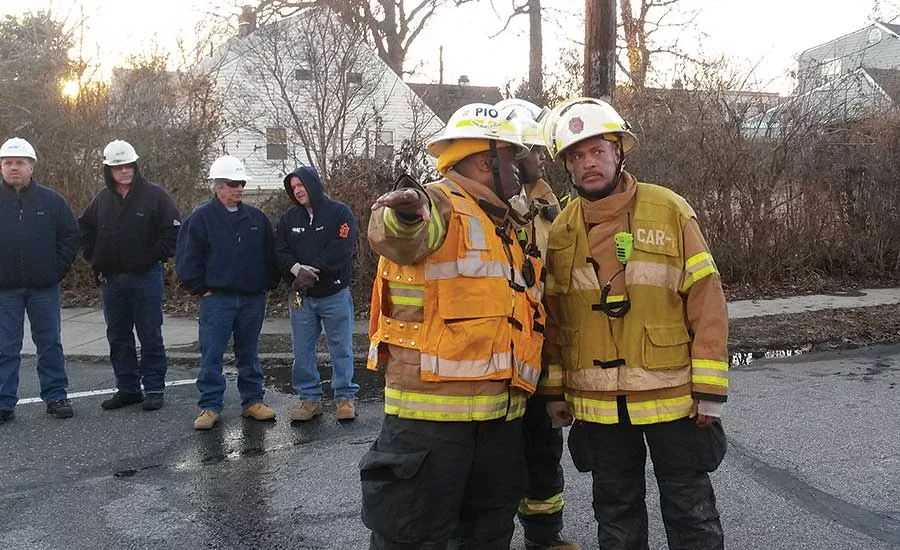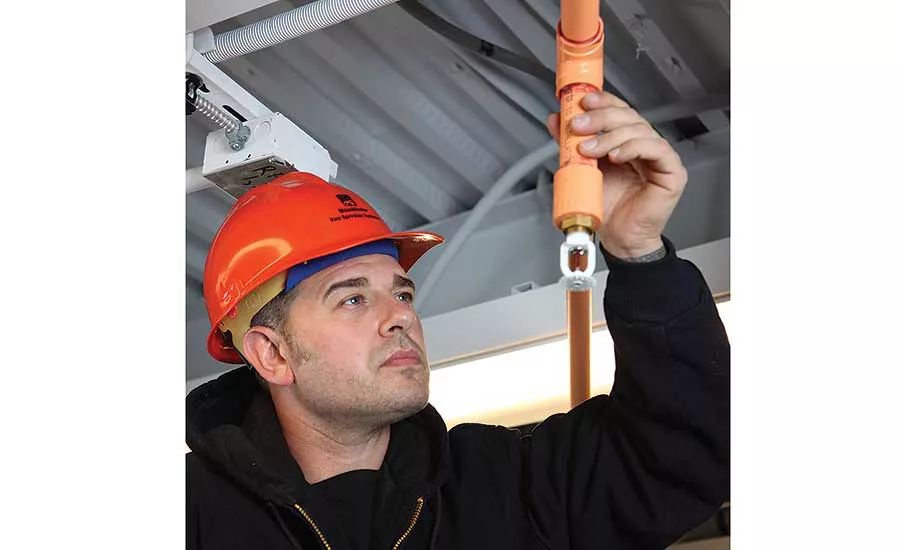NFSA fights for sprinkler ordinance
The Meridian fire caused Philadelphia and other metro departments to reevaluate how they fight high-rise fires.

Derrick Sawyer, right foreground, is leading the fight for sprinklers as the head of the National Fire Sprinkler Association (NFSA) campaign to require sprinkler retrofits in residential high-rises. Photo credit: Lubrizol Corp.

In homes with fire sprinklers, the average property loss is cut by nearly 70% compared to a home without sprinklers. Photo credit: Lubrizol Corp.
Derrick Sawyer learned the value of fire sprinklers in the most tragic way possible.
He was a Philadelphia firefighter on Feb. 23, 1991, when One Meridian Plaza, a 38-story office building downtown, caught fire.
Three firefighters were killed and 24 were injured fighting a fire that burned for more than 19 hours. The blaze gutted eight floors of the building and was stopped only when it reached a floor where a tenant had installed a sprinkler system.
“The Meridian fire killed three of our members in the line of duty and 10 sprinkler heads did what 300 firefighters couldn’t do,” says Sawyer, who rose through the fire department ranks to become Philadelphia Fire Commissioner.
Sawyer left the commissioner post in 2016 and is now leading the fight for sprinklers as the head of the National Fire Sprinkler Association (NFSA) campaign to require sprinkler retrofits in residential high-rises.
The Meridian fire caused Philadelphia and other metro departments to reevaluate how they fight high-rise fires. It also spurred cities to pass ordinances requiring sprinklers in new construction and retrofits for older commercial buildings.
However, for a variety of reasons, most cities have not required the same protection in residential high-rises, even though they pose the same dangers. Consider these cases from the last few years alone:
- Grenfell Tower, London, 24-story public housing building, no sprinklers – 71 fatalities
- Marco Polo, Honolulu, 36-story condo tower, no sprinklers – 4 fatalities
- Midtown Towers, Pittsburgh, 18-story apartment building, no sprinklers – 1 fatality
- Trump Tower, New York City, 58-story apartment building, no sprinklers – 1 fatality
“How did we fall behind and concentrate on smoke alarms and not fire sprinklers and not make sure those residential high-rises were sprinklered the same way the commercial buildings were?” Sawyer asks. “Unfortunately, in the fire service, people don’t make changes until people die.”
As leader of the NFSA’s retrofit campaign, Sawyer is trying to make sure no one else dies because a residential high-rise lacks sprinklers. The industry group last year published a new edition of its Fire Sprinkler Retrofit Guide, a resource for metro fire departments interested in passing retrofit legislation.
NFSA President Shane Ray says Sawyer’s success in drastically reducing fire deaths while commissioner initially drew the organization’s attention.
“We wanted someone with instant credibility and someone who could establish relationships with these large metropolitan departments,” he says. “Derrick does that.”
The new job requires a different mindset and timeframe than firefighting did, Sawyer says.
“When you go to a fire, it’s instant gratification,” he says. “You put the fire out, make sure everyone is out safely, and it’s done. When you’re dealing with codes and ordinances, you have to develop buy-in, you have to reach out to all the pertinent people involved. … It doesn’t happen overnight.
“The end goal is just as rewarding as putting out a fire, but it takes longer to get there,” he adds.
The Honolulu fire is a case study in how hard it can be to pass retrofit requirements, even in the wake of a tragedy. Immediately after the July 2017 blaze which left four people dead, legislation was introduced to require sprinklers in older residential high-rises. But apartment building owners and condo owners protested the cost and the original bill was watered down.
The compromise ordinance, which was signed into law in May, gives incentives, such as tax credits and fee waivers, to condo associations if they retrofit. It also requires all buildings 10 stories or higher to undergo a fire safety evaluation within three years, then decide whether to install sprinklers or take alternative fire protection measures.
In Pittsburgh, it’s been more than a year since a 75-year-old woman died in a fire in a high-rise not protected by sprinklers, but no legislation has been passed.
“That’s discouraging,” Sawyer says. “From a public safety perspective, I struggle with the fact that we haven’t done a better job of protecting our communities when we have the technology to do it.”
There have been successes, though. After a 2014 fire killed five high-rise residents, lawmakers in San Antonio, Texas, are requiring that residential towers be retrofitted with fire sprinklers. However, they have until 2027 to comply.
Portland, Oregon, now requires larger nightclubs to have sprinklers. Some smaller cities have passed laws requiring retrofits in historic districts.
The NFSA Retrofit Guide recognizes that passing legislation is a challenge. It includes everything a metro fire department might need to make its case, including statistics on fire sprinkler safety, sample retrofit ordinances, identifying barriers and advice on how to build a consensus around retrofitting. In addition, NFSA experts will travel to testify before legislative bodies and provide help and advice.
“There are certain things [fire chiefs] may not be able to say or do that we can do for them,” Sawyer says.
The NFSA wants to pass retrofit legislation in the county’s 225 largest metro areas, a goal that Sawyer admits will be difficult to accomplish.
“If we could pass it in only half the cities, think of how many lives we could save,” he says.
Looking for a reprint of this article?
From high-res PDFs to custom plaques, order your copy today!






